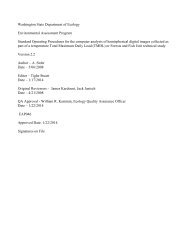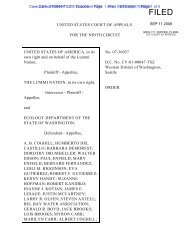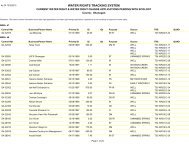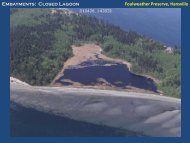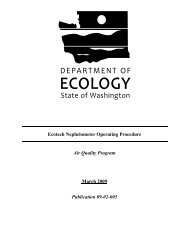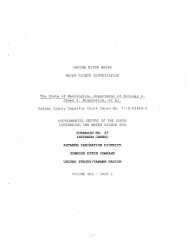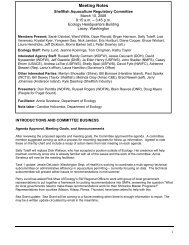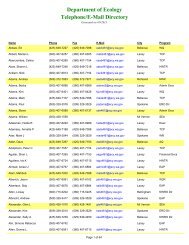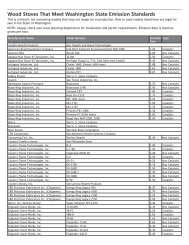General Permit for Biosolids Management - Washington State ...
General Permit for Biosolids Management - Washington State ...
General Permit for Biosolids Management - Washington State ...
Create successful ePaper yourself
Turn your PDF publications into a flip-book with our unique Google optimized e-Paper software.
<strong>General</strong> <strong>Permit</strong> <strong>for</strong> <strong>Biosolids</strong> <strong>Management</strong> Page 6<br />
“Exceptional quality biosolids” means biosolids that meet the pollutant concentration limits in Table 3<br />
of WAC 173-308-160, and at least one of the Class A pathogen reduction requirements in WAC 173-308-<br />
170, and at least one of the vector attraction reduction requirements in WAC 173-308-180.<br />
“Facility” means a treatment works treating domestic sewage as defined in this permit, unless the<br />
context of the permit requires otherwise. For the purposes of this permit a facility is considered to be<br />
new if it has not been previously approved <strong>for</strong> the treatment, storage, use, or disposal of biosolids or<br />
sewage sludge.<br />
“Feed crops” are crops produced primarily <strong>for</strong> consumption by animals.<br />
“Fiber crops” are crops such as flax and cotton including, but not limited to, those whose parts or byproducts<br />
may be consumed by humans or used in the production or preparation of food <strong>for</strong> human<br />
consumption.<br />
“Food crops” are crops consumed by humans. These include, but are not limited to, fruits, vegetables,<br />
grains, and tobacco.<br />
“Forest” is an area of land that is managed <strong>for</strong> the production of timber or other <strong>for</strong>est products, or <strong>for</strong><br />
benefits such as recreation and watershed protection, and that is or will be dominated by trees under<br />
the current system of management. For the purposes of this permit, other areas of land that are not<br />
regulated as agricultural land, public contact sites, land reclamation sites, or lawns or home gardens are<br />
considered <strong>for</strong>est land.<br />
“<strong>General</strong> permit” means a permit issued by Ecology in accordance with the procedures established in<br />
this permit, to be effective in a designated geographical area, that authorizes the application of biosolids<br />
to the land or the disposal of sewage sludge in a municipal solid waste landfill, under which multiple<br />
treatment works treating domestic sewage may apply <strong>for</strong> coverage.<br />
“Geometric mean” means the antilogarithm of the arithmetic average of the logarithms of the sample<br />
values, or the nth root of the product of n sample values.<br />
“Ground water” means water in a saturated zone or stratum beneath the surface of land or below a<br />
surface water body.<br />
“Health jurisdiction” or “local health jurisdiction” means city, county, city-county, or district public<br />
health jurisdiction as defined in Chapter 70.05 RCW, Chapter 70.08 RCW, and Chapter 70.46 RCW.<br />
“Individual permit” means a permit issued by Ecology to a single treatment works treating domestic<br />
sewage in accordance with WAC 173-308-310, which authorizes the management of biosolids or sewage<br />
sludge.<br />
“Industrial septage” or “commercial septage” is the contents from septic tanks or similar systems that<br />
receive wastewater generated in a commercial or industrial process. This definition includes, but is not<br />
limited to, grease trap wastes generated at restaurants and similar food service facilities.<br />
“Industrial wastewater” or “commercial wastewater” is wastewater generated in a commercial or<br />
industrial process.<br />
“Land application” is the application of biosolids to the land surface by means such as spreading or<br />
spraying, the injection of biosolids below the land surface, or the incorporation of biosolids into the soil,<br />
<strong>for</strong> the purpose of beneficial use.<br />
“Land with a high potential <strong>for</strong> public exposure” is land that the public uses frequently. This includes,<br />
but is not limited to, a public contact site and a reclamation site located in a populated area (<strong>for</strong><br />
example, a construction site located in a city).<br />
“Land with a low potential <strong>for</strong> public exposure” is land that the public uses infrequently. This includes,<br />
but is not limited to, agricultural land, <strong>for</strong>est, and a reclamation site located in an unpopulated area (<strong>for</strong><br />
example, a strip mine located in a rural area).<br />
“Local health jurisdiction” see definition of health jurisdiction.



